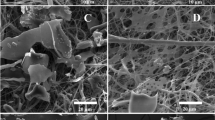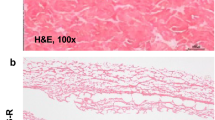ABSTRACT
We designed a composite-structure (laminar-reticular) prosthesis using expanded polytetrafluoroethylene (ePTFE) as the biomaterial in an attempt to improve the biomechanical resistance of the same biomaterial in the form of a single lamina. Defects (7 × 5 cm) were created in the abdominal wall of male white New Zealand rabbits (n = 24). The defects, which comprised all the wall layers except the skin, were then repaired with one of two types of ePTFE prosthesis. One was a latest generation laminar prosthesis (DualMesh, or Gore-Tex) and the other was a composite of in-house design (CV-4 mesh composite) made by suturing a mesh woven out of ePTFE thread to an ePTFE lamina. After sacrificing the animals at 14 or 90 days after surgery, implant specimens were subjected to morphologic analysis (light microscopy and scanning electron microscopy); and adhesion formation, neoperitoneal thickness, and biomechanical strength were evaluated. No significant differences were recorded between the two prosthesis regarding the consistency of adhesions or the area occupied by adhesions (DM 0.17 ± 0.06; CV-4 mesh composite 0.18 ± 0.08 cm2) (p > 0.05). Notably, improved tissue integration was achieved using the composite prosthesis; its reticular side became infiltrated by dense connective tissue that enveloped the mesh filaments. In contrast, the DM prosthesis became encapsulated by host tissue. The neoperitoneum induced by both prostheses was homogeneous and orderly, with a layer of typical mesothelial cells lining its inner surface. The thickness of the neoperitoneum was similar (p > 0.05) for the two implants (385.0 ± 3.4 vs. 390 ± 3.1 μm), although significantly higher (p < 0.05) mechanical resistance values were recorded for the composite prosthesis (26.75 ± 3.71 vs. 14.11 ± 3.71 N). Our findings suggest that the use of a reticular and a laminar ePTFE layer in the same prosthesis leads to better repair and biomechanical behavior compared to the use of a single-structure laminar implant.




Similar content being viewed by others
References
IL Lichtenstein AG Shulman PK Amid et al. (1989) ArticleTitleThe tension-free hernioplasty Am. J. Surg. 157 188–193 Occurrence Handle1:STN:280:BiaC3s3ptlA%3D Occurrence Handle2916733
IM Macintyre (2003) ArticleTitleBest practice in groin hernia repair Br. J. Surg. 90 131–132 Occurrence Handle10.1002/bjs.4064 Occurrence Handle1:STN:280:DC%2BD3s%2FptlCltQ%3D%3D Occurrence Handle12555287
RW Luijendijk WC Hop MP van del Tol et al. (2000) ArticleTitleA comparison of suture repair with mesh repair for incisional hernia N. Engl. J. Med. 343 392–398 Occurrence Handle10.1056/NEJM200008103430603 Occurrence Handle1:STN:280:DC%2BD3czovVKhsQ%3D%3D Occurrence Handle10933738
LJ DeGuzman LM Nyhus G Yared et al. (1995) ArticleTitleColocutaneous fistula formation following polypropylene mesh placement for repair of a ventral hernia: diagnosis by colonoscopy Endoscopy 27 459–461 Occurrence Handle1:STN:280:BymC3crmtVE%3D Occurrence Handle8549447
DK Chew LH Choi AM Rogers (2000) ArticleTitleEnterocutaneous fistula 14 years after prosthetic mesh repair of a ventral incisional hernia: a life-long risk? Surgery 127 352–353 Occurrence Handle1:STN:280:DC%2BD3c7otV2nsQ%3D%3D Occurrence Handle10715994
JA Chuback RS Sigh C Sill et al. (2000) ArticleTitleSmall bowel obstruction resulting from mesh plug migration after open inguinal hernia repair Surgery 127 475–476 Occurrence Handle1:STN:280:DC%2BD3c3jvVOnsw%3D%3D Occurrence Handle10776441
JM Bellón J Buján L Contreras et al. (1996) ArticleTitleComparison of a new type of polytetrafluoroethylene patch (Mycro Mesh) and polypropylene prosthesis (Marlex) for repair of abdominal wall defects J. Am. Coll. Surg. 183 11–18 Occurrence Handle8673302
JM Bellón J Buján L Contreras et al. (1997) ArticleTitleUse of nonpororous polytetrafluoroethylene prosthesis in combination with polypropylene prosthetic abdominal wall implants in prevention of peritoneal adhesions J. Biomed. Mater. Res. 38 197–202 Occurrence Handle10.1002/(SICI)1097-4636(199723)38:3<197::AID-JBM3>3.3.CO;2-P Occurrence Handle9283964
JM Bellón L Contreras G Pascual et al. (1999) ArticleTitleNeoperitoneal formation after implantation of various biomaterials for the repair of abdominal wall defects in rabbits Eur. J. Surg. 165 145–150 Occurrence Handle10.1080/110241599750007342 Occurrence Handle10192572
JM Bellón L Contreras J Buján et al. (1996) ArticleTitleEffect of phosphatidylcholine on the process of peritoneal adhesion following implantation of a polypropylene mesh prosthesis Biomaterials 17 1369–1372 Occurrence Handle10.1016/0142-9612(96)87276-0 Occurrence Handle8830961
JM Bellón N Garcia-Honduvilla R Lopez et al. (2003) ArticleTitle In vitro mesothelialization of prosthetic materials designed for the repair of abdominal wall defects J. Mater. Sci. (Mater. Med.) 14 359–364
M Schein DH Wittman CC Aprahamian et al. (1995) ArticleTitleThe abdominal compartment syndrome: the physiological and clinical consequences of elevated intra-abdominal pressure J. Am. Coll. Surg. 180 745–753 Occurrence Handle1:STN:280:ByqB1M7lsFU%3D Occurrence Handle7773495
JM Bellon A Garcia-Carranza F Jurado et al. (2002) ArticleTitleEvaluation of a new composite prosthesis (PL-PU99) for the repair of abdominal wall defects in terms of behavior at the peritoneal interface World J. Surg. 26 661–666 Occurrence Handle10.1007/s00268-001-0286-y Occurrence Handle12053215
JM Bellon F Jurado F García-Moreno et al. (2002) ArticleTitleHealing process induced by three composite prostheses in the repair of abdominal wall defects J. Biomed. Mater. Res. 63 182–190 Occurrence Handle10.1002/jbm.10123.abs Occurrence Handle1:CAS:528:DC%2BD38Xisl2qur4%3D Occurrence Handle11870652
Acknowledgments.
This study was supported by Grants CICYT – MAT 2001-1268 and GC2003 Biomaterials. Prosthetic biomaterials were provided by W.L. Gore and Associates.
Author information
Authors and Affiliations
Corresponding author
Rights and permissions
About this article
Cite this article
Bellón, J., Rodríguez, M., Serrano, N. et al. Improved Biomechanical Resistance Using an Expanded Polytetrafluoroethylene Composite-Structure Prosthesis. World J. Surg. 28, 461–465 (2004). https://doi.org/10.1007/s00268-004-7299-2
Published:
Issue Date:
DOI: https://doi.org/10.1007/s00268-004-7299-2




